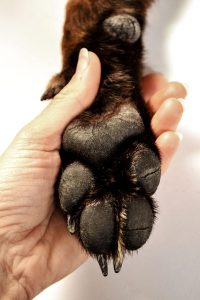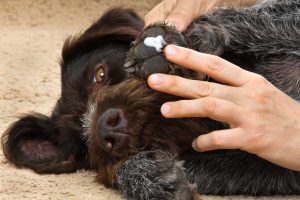Dog’s paw pads are often over looked, but they too need to be healthy. Are you aware that your dog’s paw pads need care on a regular basis? Have you ever held your dog’s paw and looked at it, like really looked at it?
Let’s begin by taking a look at what your dog’s paw pads are and what they do for them.
- Paw pads act like brakes.
- Help with their balance.
- Act as shock absorbers.
- They have a thick layer of fatty tissue that helps to insulate the inner foot from extreme temperatures.
- Paw pads are tough but not indestructible.
- Pads become rougher when exposed to rough surfaces.
- They help your dog distinguish between different types of terrain.
- The inner layer of pad skin has sweat glands which helps to keep your dog cooler and keeps the pads from drying out.
- Paw pads contain scent glands too, which is useful in territorial marking (ever wonder why your dog wipes his feet after going potty?)
There are numerous things that can damage your dog’s paw pads; here is a list of just a few of them:
- Ice
- Snow
- Salt for melting ice
- Other chemicals used to melt ice
- Hot asphalt
- Pebbles
- Foxtails
- Glass
What can you do to prevent some of these dangers?
Winter Season
During the winter when there is snow or ice on the ground, you can have your dog wear snow boots. By putting the snow boots on you will be able to protect the paws from the cold and from the salt or other chemicals used to melt the ice. Some dogs just will not tolerate having the snow boots on, so in that case, limit the time spent in the cold. When they are ready to come in, always wipe their paws. To remove the salt from the pads you can wash their paws with a mild soap and warm water.
Summer Season
During the summer, asphalt can be extremely hot and if your dog is on it for too long it can cause blistering of the pads, tissue loss, and cause them extreme pain. A good rule of thumb….If you can’t walk barefoot on the asphalt then your dog shouldn’t either. Try to reschedule your walks for when it is cooler like in the early morning or later in the evening. You can go for a walk in grassy areas like at a park or a nearby field as well.
Hiking
Always inspect your dog’s paw pads after a walk, especially if you take your dog hiking. Check to see if any foreign objects like foxtails and/or pebbles have made its way in between the pads and toes. You can also trim the fur between the pads and toes, by doing so, you will help reduce the amount of snow, salt, fox tails, and dirt that cling to the fur.
Cracked Paw Pads

Some cracking of the paw pads is considered to be the usual “wear and tear” and is pretty normal for very active, outdoorsy dogs. You can take care of your dog’s cracked paw pads at home by washing their paws with an antibacterial soap and warm water, pat them dry, and apply a petroleum jelly. When you apply the jelly, make sure to rub it in well. You can also use an all-natural paw pad balm. DO NOT USE any human moisturizers as it can soften the pads too much and can lead to injury. You can also put socks or booties on your dog’s paws to make walking on cracked pads a bit more bearable, if they will tolerate them. Limit the length of your walks if their pads are causing too much discomfort.

What are some other ways that you take care of your dog’s paw pads?

Leave A Comment